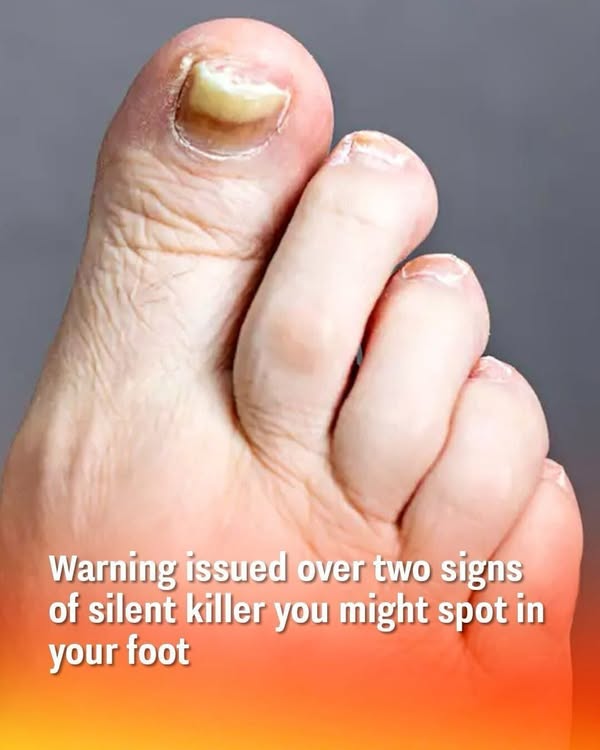Pharmacist Reveals 2 Subtle Foot Symptoms That Could Signal a Silent Killer

You might not give much thought to your feet beyond comfort or aesthetics—but did you know they could be sending early signals of serious, life-threatening conditions?
According to health professionals, seemingly minor changes in your feet can indicate underlying diseases like Peripheral Artery Disease (PAD) and diabetes-related complications—both known as “silent killers” due to their stealthy, symptom-free progression. Catching these warning signs early can make all the difference.
Let’s explore the two critical symptoms to watch for in your feet, what causes them, and how to respond before the danger escalates.
The Hidden Threats: PAD and Diabetes
1. Peripheral Artery Disease (PAD)
PAD occurs when fatty deposits build up in the arteries, narrowing blood vessels and restricting blood flow—particularly to the legs and feet. It’s more than just a circulation issue: PAD is often a red flag for systemic cardiovascular disease and raises the risk of heart attacks, strokes, and even limb amputation.
2. Diabetes and Its Complications
Uncontrolled diabetes damages nerves (diabetic neuropathy) and blood vessels, especially in the extremities. This makes the feet vulnerable to injury, slow-healing wounds, and infections. Left unchecked, these complications can lead to ulcers, gangrene, or amputation.
Because both conditions can develop silently, the first warning signs may show up in your feet—if you know what to look for.
Two Warning Signs in Your Feet You Should Never Ignore
1. Persistent Coldness or Skin Discoloration
If your feet frequently feel cold or appear pale, bluish, or even darkened, this could point to poor circulation—a hallmark of PAD or diabetes-related vascular damage.
Why This Happens:
- PAD: Narrowed arteries prevent adequate blood flow, causing cool, discolored skin.
- Diabetes: Damaged nerves dull temperature sensitivity, and impaired blood flow limits oxygen delivery to tissues.
Why It’s Dangerous:
Reduced circulation slows healing and raises infection risk. In severe cases, tissue death (gangrene) can occur. Cold, discolored feet should always be evaluated by a medical professional—especially if symptoms persist.
2. Slow-Healing Sores or Ulcers
Even a small cut or blister on your foot can become a serious issue if it heals slowly—or not at all.
Why This Happens:
- Diabetes: High blood sugar damages capillaries and nerves, reducing both sensation and healing ability.
- PAD: Poor blood flow means vital nutrients and oxygen don’t reach the wound site, delaying recovery.
Why It’s Dangerous:
Untreated wounds may become infected, leading to:
- Cellulitis or abscesses
- Tissue death (gangrene)
- Sepsis or amputation
Slow-healing wounds are not just a foot problem—they’re often a sign of bigger health issues that demand urgent attention.
Other Symptoms You Might Notice
These additional signs may accompany PAD or diabetes complications:
- Tingling or numbness: Often caused by nerve damage.
- Foot pain while walking (claudication): A sign of restricted blood flow.
- Swelling: May suggest fluid retention, heart or kidney involvement.
Are You at Risk? Know the Triggers
Understanding what increases your vulnerability can help with early detection and prevention:
- Age: Risk rises after 50.
- Smoking: Damages arteries and worsens diabetes complications.
- Obesity: Strains the heart and contributes to insulin resistance.
- Family history: Genetics play a role in both PAD and diabetes.
- Inactivity: A sedentary lifestyle encourages poor circulation and metabolic issues.
Prevention and Management Tips
1. Practice Daily Foot Care
- Inspect feet for cuts, color changes, or swelling.
- Keep feet clean and moisturized.
- Wear supportive, well-fitting shoes.
2. Control Blood Sugar
- Follow your doctor’s guidance on diet, medications, and glucose monitoring.
3. Stop Smoking
- Smoking cessation significantly reduces the risk of PAD and improves circulation.
4. Get Moving
- Aim for 30 minutes of moderate exercise at least 5 days a week to boost circulation.
5. Monitor Cardiovascular Health
- Keep blood pressure and cholesterol in check with regular screenings and treatment if needed.
6. Seek Medical Advice Promptly
- Never ignore cold feet, changes in skin color, or wounds that won’t heal.
Conclusion: Don’t Ignore What Your Feet Are Telling You
Your feet may be far from your heart, but they’re often the first to show signs of serious internal health problems. Coldness, discoloration, and slow-healing sores are more than just inconveniences—they could be the first symptoms of life-threatening conditions like PAD or diabetes complications.
By paying attention to these subtle signs and acting early, you can take control of your health and prevent dangerous complications. Remember: your feet are a vital window into your overall well-being.